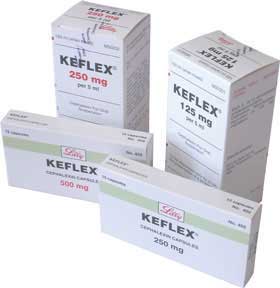 | |
Generic Keflex 250 mg
| | 24 pillole - 31.4 EURO (1.31 EURO/pillola) | Aggiungi al carrello | | 48 pillole - 61.12 EURO (1.27 EURO/pillola) | Aggiungi al carrello | | 72 pillole - 87.48 EURO (1.21 EURO/pillola) | Aggiungi al carrello |
Keflex is used for treating certain bacterial infections. Keflex is a cephalosporin antibiotic. It works by interfering with the bacteria's cell wall formation. This weakens the cell wall, causing it to rupture, and kills the bacteria.
Synonyms: Alcephin; Cepcid; Cephasun; Cepmax; Phexin Bd; Alexin; Biocef; Carnosporin; Cefadal; Cefadin; Cefalin; Cefax; Ceforal; Cefovit;
Per ordini più grandi la tassa di trasporto Posta Raccomandata sarà applicata per ogni 100 pillole.
Per ordini superiori a 300 pillole oppure bulk ordini, si e' invitati a contattare [email protected] alfine di ottenere un prezzo speciale.
Spedito da: EU
Out of stock |
|
Generic Name: Cephalexin Capsules (SEF-a-LEX-in)
Brand Name: Keflex
Keflex is used for:
Treating certain bacterial infections. Keflex is a cephalosporin antibiotic. It works by interfering with the bacteria's cell wall formation. This weakens the cell wall, causing it to rupture, and kills the bacteria.
Do NOT use Keflex if:
- you are allergic to any ingredient in Keflex or any other cephalosporin antibiotic (eg, cefuroxime)
Contact your doctor or health care provider right away if any of these apply to you.
Before using Keflex:
Some medical conditions may interact with Keflex . Tell your doctor or pharmacist if you have any medical conditions, especially if any of the following apply to you:
- if you are pregnant, plan to become pregnant, or are breast-feeding
- if you are taking any prescription or nonprescription medicine, herbal preparation, or dietary supplement
- if you have allergies to medicines, foods, or other substance
- if you have had a severe allergic reaction (eg, severe rash, hives, breathing difficulties, dizziness) to a penicillin (eg, amoxicillin) or other beta-lactam antibiotic (eg, imipenem)
- if you have stomach or bowel problems (eg, inflammation), blood clotting problems, kidney or liver problems, or poor nutrition
Some MEDICINES MAY INTERACT with Keflex . Tell your health care provider if you are taking any other medicines, especially any of the following:
- Metformin because its actions and the risks of its side effects may be increased by Keflex
- Probenecid because it may increase the actions and the risk of Keflex 's side effects
- Anticoagulants (eg, warfarin) because the risk of side effects such as bleeding may be increased
This may not be a complete list of all interactions that may occur. Ask your health care provider if Keflex may interact with other medicines that you take. Check with your health care provider before you start, stop, or change the dose of any medicine.
How to use Keflex:
Use Keflex as directed by your doctor. Check the label on the medicine for exact dosing instructions.
- Take Keflex by mouth with or without food.
- To clear up your infection completely, take Keflex for the full course of treatment. Keep taking it even if you feel better in a few days.
- If you miss a dose of Keflex , take it as soon as possible. If it is almost time for your next dose, skip the missed dose and go back to your regular dosing schedule. Do NOT take 2 doses at once.
Ask your health care provider any questions you may have about how to use Keflex .
Important safety information:
- Keflex may cause dizziness. These effects may be worse if you take it with alcohol or certain medicines. Use Keflex with caution. Do not drive or perform other possibly unsafe tasks until you know how you react to it.
- Keflex may decrease the ability of your blood to clot. Avoid activities that may cause bruising or injury. Tell your doctor if you have unusual bruising or bleeding. Tell your doctor if you have dark, tarry, or bloody stools.
- Contact your doctor right away if stomach pain or cramps, severe diarrhea, or bloody stools occur. Do not treat diarrhea without first checking with your doctor.
- Be sure to use Keflex for the full course of treatment. If you do not, the medicine may not clear up your infection completely. The bacteria could also become less sensitive to this or other medicines. This could make the infection harder to treat in the future.
- Keflex only works against bacteria; it does not treat viral infections (eg, the common cold).
- Long-term or repeated use of Keflex may cause a second infection. Tell your doctor if signs of a second infection occur. Your medicine may need to be changed to treat this.
- Diabetes patients - Keflex may cause the results of some tests for urine glucose to be wrong. Ask your doctor before you change your diet or the dose of your diabetes medicine.
- Keflex may interfere with certain lab tests. Be sure your doctor and lab personnel know you are taking Keflex.
- Use Keflex with caution in the ELDERLY; they may be more sensitive to its effects.
- Use Keflex with extreme caution in CHILDREN younger than 10 years old who have diarrhea or an infection of the stomach or bowel.
- PREGNANCY and BREAST-FEEDING: If you become pregnant, contact your doctor. You will need to discuss the benefits and risks of using Keflex while you are pregnant. Keflex is found in breast milk. If you are or will be breast-feeding while you use Keflex , check with your doctor. Discuss any possible risks to your baby.
Possible side effects of Keflex:
All medicines may cause side effects, but many people have no, or minor, side effects. Check with your doctor if any of these most COMMON side effects persist or become bothersome:
- Diarrhea; dizziness; headache; indigestion; joint pain; stomach pain; tiredness.
Seek medical attention right away if any of these SEVERE side effects occur:
- Severe allergic reactions (rash; hives; itching; difficulty breathing; tightness in the chest; swelling of the mouth, face, lips, or tongue); agitation; confusion; dark urine; decreased urination; fever; hallucinations; red, swollen, or blistered skin; seizures; severe or blood diarrhea; severe stomach pain; severe tiredness; unusual bruising or bleeding; unusual vaginal pain, odor, or discharge; yellowing of the eyes or skin.
This is not a complete list of all side effects that may occur.
Proper storage of Keflex:
Store Keflex at 77 degrees F (25 degrees C). Brief storage at temperatures between 59 and 86 degrees F (15 and 30 degrees C) is permitted. Store away from heat, moisture, and light. Do not store in the bathroom. Keep Keflex out of the reach of children and away from pets.
|
|
|














